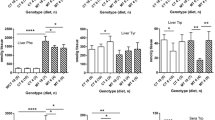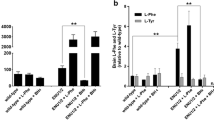Abstract
Transport of large neutral amino acids (LNAA) across the blood brain barrier (BBB) is facilitated by the L-type amino acid transporter, LAT1. Peripheral accumulation of one LNAA (e.g., phenylalanine (phe) in PKU) is predicted to increase uptake of the offending amino acid to the detriment of others, resulting in disruption of brain amino acid homeostasis. We hypothesized that selected non-physiological amino acids (NPAAs) such as DL-norleucine (NL), 2-aminonorbornane (NB; 2-aminobicyclo-(2,1,1)-heptane-2-carboxylic acid), 2-aminoisobutyrate (AIB), and N-methyl-aminoisobutyrate (MAIB), acting as competitive inhibitors of various brain amino acid transporters, could reduce brain phe in Pah enu2 mice, a relevant murine model of PKU. Oral feeding of 5 % NL, 5 % AIB, 0.5 % NB and 3 % MAIB reduced brain phe by 56 % (p < 0.01), -1 % (p = NS), 27 % (p < 0.05) and 14 % (p < 0.01), respectively, compared to untreated subjects. Significant effects on other LNAAs (tyrosine, methionine, branched chain amino acids) were also observed, however, with MAIB displaying the mildest effects. Of interest, MAIB represents an inhibitor of the system A (alanine) transporter that primarily traffics small amino acids and not LNAAs. Our studies represent the first in vivo use of these NPAAs in Pah enu2 mice, and provide proof-of-principle for their further preclinical development, with the long-term objective of identifying NPAA combinations and concentrations that selectively restrict brain phe transport while minimally impacting other LNAAs and downstream intermediates.








Similar content being viewed by others
Abbreviations
- 3-MT:
-
3-methoxytyramine
- 5-HIAA:
-
5-hydroxyindoleacetic acid
- 5-HT:
-
Serotonin
- 5-HTP:
-
5-hydroxytryptophan
- AIB:
-
Aminoisobutyric acid
- BBB:
-
Blood brain barrier
- DA:
-
Dopamine
- DOPAC:
-
3,4-dihydroxyphenylacetic acid
- HVA:
-
Homovanillic acid
- Ile; I:
-
Isoleucine
- L-DOPA:
-
L-dihydroxyphenylalanine
- LAT1:
-
L-type amino acid transporter
- Leu; L:
-
Leucine
- LNAA:
-
Large neutral amino acid
- NL:
-
DL-norleucine
- MAIB:
-
Methyl-aminoisobutyric acid
- Met; M:
-
Methionine
- NB:
-
2-aminobicyclo(2,2,1)heptane-2-carboxylic acid (2-aminonorbornane)
- NPAA:
-
Non-physiological amino acid
- PAH:
-
Phenylalanine hydroxylase
- Phe; F:
-
Phenylalanine
- PKU:
-
Phenylketonuria
- SAH:
-
S-adenosylhomocysteine
- SAMe:
-
S-adenosylmethionine
- Trp; W:
-
Tryptophan
- Tyr; Y:
-
Tyrosine
- Val; V:
-
Valine
References
Aaslestad HG, Larson AD (1964) Bacterial metabolism of 2-methylalanine. J Bacteriol 88:1296–1303
Arning E, Bottiglieri T, Sun Q et al (2009) Metabolic profiling in phenylalanine hydroxylase-deficient (Pah-/-) mouse brain reveals decreased amino acid neurotransmitters and preferential alterations of the serotoninergic system. Mol Genet Metab 98:21
Babu E, Kanai Y, Chairoungdua A et al (2003) Identification of a novel system L amino acid transporter structurally distinct from heterodimeric amino acid transporters. J Biol Chem 278:43838–43845
Bodoy S, Martín L, Zorzano A, Palacín M, Estévez R, Bertran J (2005) Identification of LAT4, a novel amino acid transporter with system L activity. J Biol Chem 280:12002–12011
Bröer S, Brookes N (2001) Transfer of glutamine between astrocytes and neurons. J Neurochem 77:705–719
Choi TB, Pardridge WM (1986) Phenylalanine transport at the human blood–brain barrier. Studies with isolated human brain capillaries. J Biol Chem 261:6536–6541
Christensen HN, Streicher JA, Elbinger RL (1948) Effects of feeding individual amino acids upon the distribution of other amino acids between cells and extracellular fluid. J Biol Chem 172:515–524
Christensen HN (1990) Role of amino acid transport and countertransport in nutrition and metabolism. Physiol Rev 70:43–77
Chrostowski MK, McGonnigal BG, Stabila JP, Padbury JF (2009) LAT-1 expression in pre- and post-implantation embryos and placenta. Placenta 30:270–276
Crawhall JC, Purkiss P (1973) Transport of methionine and proline by rat liver slices and the effect of certain hormones. Biochem J 136:15–24
Der Garabedian PA, Vermeersch JJ (1987) Candida L-norleucine, leucine:2-oxoglutarate aminotransferase. Purification and properties. Eur J Biochem 167:141–147
Dotremont H, Francois B, Diels M, Gillis P (1995) Nutritional value of essential amino acids in the treatment of adults with phenylketonuria. J Inherit Metab Dis 18:127–130
Ennis SR, Ren XD, Betz AL (1994) Transport of alpha-aminoisobutyric acid across the blood–brain barrier studied with in situ perfusion of rat brain. Brain Res 643:100–107
Enns GM, Koch R, Brumm V, Blakely E, Suter R, Jurecki E (2010) Suboptimal outcomes in patients with PKU treated early with diet alone: revisiting the evidence. Mol Genet Metab 101:99–109
Geldenhuys WJ, Van der Schyf CJ (2011) Role of serotonin in Alzheimer’s disease: a new therapeutic target. CNS Drugs 25:765–781
Han SJ, Choi S-E, Yi S-A et al (2012) β-Cell-protective effect of 2-aminobicyclo-(2,1,1)-heptane-2-carboxylic acid as a glutamate dehydrogenase activator in db/db mice. J Endocrinol 212:307–315
Kanai Y, Segawa H, Miyamoto K, Uchino H, Takeda E, Endou H (1998) Expression cloning and characterization of a transporter for large neutral amino acids activated by the heavy chain of 4F2 antigen (CD98). J Biol Chem 273:23629–23632
Knudsen GM, Hasselbalch S, Toft PB, Christensen E, Paulson OB, Lou H (1995) Blood–brain barrier transport of amino acids in healthy controls and in patients with phenylketonuria. J Inherit Metab Dis 18:653–664
Kurian MA, Gissen P, Smith M, Heales S Jr, Clayton PT (2011) The monoamine neurotransmitter disorders: an expanding range of neurological syndromes. Lancet Neurol 10:721–733
Lepley PR, Mukkada AJ (1983) Characteristics of an uptake system for alpha-aminoisobutyric acid in Leishmania tropica promastigotes. J Protozool 30:41–46
Lin J, Raoof DA, Thomas DG et al (2004) L-type amino acid transporter-1 overexpression and melphalan sensitivity in Barrett’s adenocarcinoma. Neoplasia 6:74–84
Matalon R, Michals-Matalon K, Bhatia G et al (2006) Large neutral amino acids in the treatment of phenylketonuria (PKU). J Inherit Metab Dis 29:732–738
McKean CM, Boggs DE, Peterson NA (1968) The influence of high phenylalanine and tyrosine on the concentrations of essential amino acids in brain. J Neurochem 15:235–241
Michals-Matalon K, Bhatia G, Guttler F, Tyring SK, Matalon R (2007) Response of phenylketonuria to tetrahydrobiopterin. J Nutr 137:1564S–1567S
Ogburn KD, Bottiglieri T, Wang Z, Figueiredo-Pereira ME (2006) Prostaglandin J2 reduces catechol-O-methyltransferase activity and enhances dopamine toxicity in neuronal cells. Neurobiol Dis 22:294–301
Pietz J, Kreis R, Rupp A, Mayatepek E, Rating D, Boesch C, Bremer HJ (1999) Large neutral amino acids block phenylalanine transport into brain tissue in patients with phenylketonuria. J Clin Invest 103:1169–1178
Pisoni RL, Flickinger KS, Thoene JG, Christensen HN (1987) Characterization of carrier-mediated transport systems for small neutral amino acids in human fibroblast lysosomes. J Biol Chem 262:6010–6017
Segawa H, Fukasawa Y, Miyamoto K, Takeda E, Endou H, Kanai Y (1999) Identification and functional characterization of a Na + -independent neutral amino acid transporter with broad substrate selectivity. J Biol Chem 274:19745–19751
Shennan DB, McNeillie SA (1994) Characteristics of alpha-aminoisobutyric acid transport by lactating rat mammary gland. J Dairy Res 61:9–19
Skvorak KJ, Hager EJ, Arning E et al (2009) Hepatocyte transplantation (HTx) corrects selected neurometabolic abnormalities in murine intermediate maple syrup urine disease (iMSUD). Biochim Biophys Acta 1792:1004–1010
Smith QR, Momma S, Aoyagi M, Rapoport SI (1987) Kinetics of neutral amino acid transport across the blood–brain barrier. J Neurochem 49:1651–1658
Tews JK, Harper AE (1986) Tissue amino acids in rats fed norleucine, norvaline, homoarginine or other amino acid analogues. J Nutr 116:1464–1472
Tews JK, Repa JJ, Harper AE (1990) Norleucine: a branched-chain amino acid analog affecting feeding behavior of rats. Pharmacol Biochem Behav 35:911–921
Tews JK, Repa JJ, Harper AE (1991) Branched-chain and other amino acids in tissues of rats fed leucine-limiting amino acid diets containing norleucine. J Nutr 121:364–378
Tovar A, Tews JK, Torres N, Harper AE (1988) Some characteristics of threonine transport across the blood–brain barrier of the rat. J Neurochem 51:1285–1293
van Spronsen FJ, Enns GM (2010) Future treatment strategies in phenylketonuria. Mol Genet Metab 99:S90–S95
van Spronsen FJ, de Groot MJ, Hoeksma M, Reijngoud DJ, van Rijn M (2010) Large neutral amino acids in the treatment of PKU: from theory to practice. J Inherit Metab Dis 33:671–676
Wadhwani KC, Smith QR, Rapoport SI (1990) Facilitated transport of L-phenylalanine across blood-nerve barrier of rat peripheral nerve. Am J Physiol 258:R1436–R1444
Zagreda L, Goodman J, Druin DP, McDonald D, Diamond A (1999) Cognitive deficits in a genetic mouse model of the most common biochemical cause of human mental retardation. J Neurosci 19:6175–6182
Zinnanti WJ, Lazovic J, Griffin K et al (2009) Dual mechanism of brain injury and novel treatment strategy in maple syrup urine disease. Brain 132:903–918
Acknowledgements
The authors are indebted to Dr. Cary Harding, Oregon Health Sciences University, for providing the Pah enu2 murine model, and to Dr. Kristen J. Skvorak for supplying wild-type subjects for characterization of brain amino acids and monoamines. The guidance and advice of Drs. Viktor Kozich, Harvey Mudd, and William Zinnanti are gratefully acknowledged. This work was supported by a grant from the National PKU Alliance (www.npkua.org), which is gratefully acknowledged.
Conflict of interest
None.
Author information
Authors and Affiliations
Corresponding author
Additional information
Communicated by: Nenad Blau
Rights and permissions
About this article
Cite this article
Vogel, K.R., Arning, E., Wasek, B.L. et al. Non-physiological amino acid (NPAA) therapy targeting brain phenylalanine reduction: pilot studies in PAH ENU2 mice. J Inherit Metab Dis 36, 513–523 (2013). https://doi.org/10.1007/s10545-012-9524-8
Received:
Revised:
Accepted:
Published:
Issue Date:
DOI: https://doi.org/10.1007/s10545-012-9524-8




